The ASCO Post remembers the following members of the oncology community who passed away in 2016–2017. Please write to editor@ASCOPost.com to recognize others and pay tribute in a future issue.
Stephen K. Carter, MD
October 30, 1937–November 14, 2016
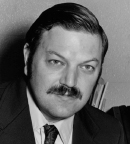
Stephen K. Carter, MD
Stephen K. Carter, MD, a renowned oncologist who held a variety of executive positions in the pharmaceutical industry and played a major role in the research and development of many widely used cancer and AIDS drugs, died on November 14, 2016, after a long battle against multiple systems atrophy. He was 79. Steve’s passing marks the end of an era: He was inspirational to a generation of oncologists.
In the spring of 1976, at the ASCO Annual Meeting in Toronto, those of us connected with the Cancer Therapy Evaluation Program of the National Cancer Institute (NCI) came together for a farewell party to Steve, as he was leaving for Stanford University after an impressive 10-year span at the NCI, where he rose to be CTEP’s Director and Deputy Director of the Division of Cancer Treatment.
CTEP’s mission, in fact, was forged by Steve Carter’s enthusiasm and organizational skills in canvassing NCI resources toward coordinated efforts in clinical drug development, at a time when the pharmaceutical industry was not prominently involved in clinical trials. Steve was quick to recognize that a critical analysis of clinical studies and introduction of new drugs and new modalities were essential in making advances in cancer treatment.
Steve Carter became a prominent and dynamic figure in the global development of cancer chemotherapy, responsible for opening doors to young clinical investigators in the international arena. He capably represented the NCI and U.S. oncologic activities in various international collaborative exchanges. In 1985, after serving at the NCI and 6 years at the helm of Northern California’s Cancer Program and Professor at Stanford, Steve joined Bristol-Myers—in 1989 renamed Bristol-Myers Squibb—in charge of oncology and HIV drugs. In this new role, he was instrumental in developing drugs to increase the armamentarium against cancer and AIDS and mentoring many junior colleagues. He maintained this role until stepping down in the late 1990s, while continuing to work as a consultant for emerging pharmaceutical development programs.
Steve received his BA in American history from Columbia University and his MD from New York Medical College in 1963. He completed his medical internship and residency at Lenox Hill Hospital in New York, where he became Chief Medical Resident. He went on to publish numerous papers and books on cancer treatment. In addition to his various positions in the pharmaceutical industry, in 1994, President Clinton named Steve to an 18-member panel of scientists, physicians, and advocates for patients with AIDS to help speed the search for new drugs to combat the virus that causes AIDS.
Steve had a lifelong passion for opera, classical music, and the theater. Steve was a voluminous reader, world traveler, political junkie, and dedicated sports fan. He will be remembered most of all as a generous, loving husband, father, and grandfather.
Learning of Steve’s death, James Holland, MD, reflected upon his NCI accomplishments: “Steve was one of the most important clinical leaders of the NCI in its glory days under Gordon Zubrod. He mentored many who later became leaders and was a paragon of literature review. Usually, his mentee became the first author, but if Steve’s name was on it, we could all trust that it was an exhaustive and critical analysis of the relevant literature. For older oncologists outside the NCI like Tom Frei and myself, he was a bedrock of information and a generous and helpful colleague. Medical oncology owes him great respect and gratitude. There has been no one like him since.”
Gregory A. Curt, MD
July 26, 1952–July 31, 2016
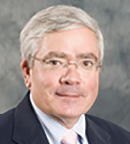
Gregory A. Curt, MD
Gregory A. Curt, MD, former Clinical Director at the National Cancer Institute (NCI) and nationally regarded expert on translational oncology died on July 31, 2016. He was 64 years old. Dr. Curt received his MD with distinction in research from the University of Rochester School of Medicine in 1977. He completed his training in internal medicine as an intern and resident at the New England Deaconess Hospital and as a research fellow at the Peter Bent Brigham Hospital, Harvard Medical School.
Dr. Curt completed his medical oncology training in the Medicine Branch of the NCI from 1980 to 1983, following which he coordinated the intramural NCI Phase I Cancer Drug Development Program. Dr. Curt served as Deputy Director of the NCI’s Division of Cancer Treatment from 1985 to 1988, overseeing the Division’s extramural research grant and contract portfolios. He was appointed Clinical Director of the NCI in 1989.
During his years as Clinical Director, Dr. Curt led the intramural program at the NCI increasingly toward translational research involving new therapeutic modalities including anticancer drugs, immunotoxins, and vaccines. He was awarded the Outstanding Service Medal of the U.S. Public Health Service in 1992.
Dr. Curt joined AstraZeneca Oncology in 2002 as Senior Director and Alliance Manager for the National Institutes of Health. Under his leadership, AstraZeneca created important new partnerships with the NCI in cancer drug development as well as cancer prevention and treatment including novel combinations.
Dr. Curt served as U.S. Medical Science Lead for Strategic Alliances, Physician Lead for the U.S. Oncology Phase I Team, and U.S. Group Director for late-stage drug strategy in Global Medicines Development. At the time of his death, he was Executive Director for External Relations in U.S. Medical Affairs at AstraZeneca Oncology.
Alfred George Knudson, MD, PhD
August 9, 1922–July 10, 2016
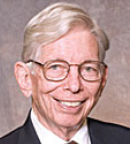
Alfred George Knudson, MD, PhD
Alfred George Knudson, MD, PhD, was internationally recognized for his “two-hit theory” of cancer causation, which explained the relationship between hereditary and nonhereditary cancer types, predicting the existence of tumor suppressor genes. Dr. Knudson died on July 10, 2016. He was 94.
Dr. Knudson was born in Los Angeles on August 9, 1922. After high school, he entered the California Institute of Technology in 1940. He originally planned on a career in physics, but after 2 years, he switched his major to biology, working in the laboratory of Thomas Hunt Morgan, who won the Nobel Prize in Physiology or Medicine in 1933 for discoveries elucidating the role the chromosome plays in heredity.
During his time at Caltech, World War II broke out, and Dr. Knudson joined the Navy. An officer explained that they didn’t need PhDs in genetics; the war effort needed doctors and engineers, and he advised Dr. Knudson to stay in school. He entered Columbia University, receiving his MD in 1947.
During an interview, Dr. Knudson said his initial interest in cancer did not come during medical school. “At that time, we had almost no instructions in cancer. You could either remove the tumor surgically or let people die. During my first year of residency at Cornell New York Hospital, I spent 1 month across the street at Memorial, which had a 20-bed pediatric cancer unit and no full-time pediatrician. I spent a month dealing with children with cancer, and it made a very deep impression. That was when I decided to work in the cancer field,” said Dr. Knudson.
In 1953, James Watson and Francis Crick published their famous paper on the discovery of DNA, which rocked the world, especially the world of the aspiring young geneticist. Dr. Knudson returned to Caltech to earn his PhD. While he was there, James Watson arrived to do work on RNA. It was a formative time in Dr. Knudson’s career.
Dr. Knudson came to Fox Chase from The University of Texas Graduate School of Biomedical Sciences, where he was Dean, and the MD Anderson Hospital and Tumor Institute in Houston, where he specialized in pediatrics and biology. Previously, he was Associate Dean for Basic Sciences at the State University of New York at Stony Brook from 1966 to 1969.
He began his affiliation with Fox Chase in 1970 as a member of its scientific advisory committee, and it was there in 1971 that he did his seminal work leading to the Knudson Hypothesis, otherwise known as the “two-hit hypothesis.” This now-confirmed theory advanced the understanding of errors in the genetic program that turn normal cells into cancer cells and guided later investigations by tumor geneticists and molecular biologists.
Dr. Knudson spent most of his career at Fox Chase Cancer Center, where he held several management positions, including that of President. Dr. Knudson and his wife, Anna T. Meadows, MD, who was a pediatric oncologist at Children’s Hospital of Philadelphia, collaborated on the study of the genetics of childhood cancer. [Dr. Meadows is profiled in this issue;].
Charles A. LeMaistre, MD
February 10, 1924–January 28, 2017
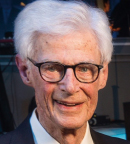
Charles A. “Mickey” LeMaistre, MD
In 1978, Charles A. “Mickey” LeMaistre, MD, was named President of The University of Texas MD Anderson Cancer Center. During his 18-year tenure, MD Anderson became a world leader in outpatient care for cancer patients and the nation’s largest ambulatory treatment and surgery programs in cancers. In 2015, Dr. LeMaistre was inducted into the Health Care Hall of Fame. Dr. LeMaistre died on January 28, 2017, in Houston, Texas. He was 92.
Dr. LeMaistre was born on February 10, 1924, in Lockhart, Alabama. At birth, his father gave him the nickname “Mickey,” a sobriquet that Dr. LeMaistre preferred over his given name, Charles. His decision to pursue a career in medicine was due, at least in part, to an encounter with the medical world when, as a 10-year-old, he suffered a ruptured appendix while walking in the woods with his German Shepherd, Inga. He recalled the incident during an interview.
“I was lying on the ground, and Inga took off and left me alone. She went to my home and got two of my brothers, who carried me back. I was operated on immediately. It was a lesson I reflected on many times, because there was some reason why I survived that.”
Dr. LeMaistre had an early interest in becoming a doctor and had planned on attending the Naval Academy in Annapolis, on an appointment from then Alabama senator, Lister Hill. But a week before entering the Academy, he suffered a serious eye injury that made him ineligible. Instead, Dr. LeMaistre attended the University of Alabama in Tuscaloosa, the town where he moved with his mother and five older siblings after his father’s death.
After receiving his undergraduate degree, he went to Cornell University, receiving his MD in 1947. Following graduation, Dr. LeMaistre stayed at Cornell as a faculty member, teaching and practicing medicine. In 1954, he left Cornell and joined Emory University in Atlanta, where he stayed for 5 years teaching in internal medicine and conducting a research program. While at Emory, Dr. LeMaistre started a department of preventive medicine; highlighting prevention would be the hallmark of his career.
Dr. LeMaistre left Atlanta in 1959 to become Professor of Internal Medicine at the University of Texas Southwestern Medical School in Dallas. In Dallas, Dr. LeMaistre’s crusade against cancer blossomed, as he was chosen as 1 of 10 members on the first surgeon general’s advisory committee on smoking and health, which would author the landmark 1964 report that labeled tobacco as the leading cause of lung cancer.
In 1971, Dr. LeMaistre was elected Chancellor for the University of Texas Medical School and directed a huge expansion of the University of Texas system, which included new medical schools in Houston and San Antonio. In 1978, he assumed the presidency of The University of Texas MD Anderson Cancer Center. While serving at MD Anderson, Dr. LeMaistre developed a cancer prevention division that focused on epidemiology, behavioral sciences, and working with patients who had a family history of cancer. He also played a major role in expanding the center beyond Houston, bringing it to the community rather than requiring patients to come to the cancer center.
Dr. LeMaistre continued to play a role in the fight against cancer until his death.
Robert B. Livingston, MD
June 3, 1941–September 8, 2016
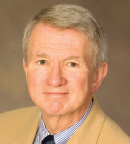
Robert B. Livingston, MD
Robert B. Livingston, MD, a pioneer in chemoradiation, died on September 8, 2016.
Dr. Livingston completed his medical internship at Parkland Hospital, Southwestern Medical School in Dallas and did his medical residency at the University of Oklahoma College of Medicine. He performed his oncology fellowship from 1971 to 1973 at the University of Texas (UT) System Cancer Center. After that, Dr. Livingston continued his career in oncology, research, and teaching at a number of esteemed institutions. At the time of his death, Dr. Livingston was Professor of Medicine and Hematologic Oncology at the University of Arizona College of Medicine, specializing in breast cancer.
Dr. Livingston had more than 30 years of international clinical research experience in both breast and lung cancers. He formerly chaired the Breast Cancer Committee of SWOG and was one of the country’s strongest advocates and experts on clinical trials and clinical research.
Dr. Livingston introduced the use of concurrent chemotherapy and radiation for limited small cell lung cancer, which produced acceptable toxicity and results superior to those with the use of either therapy alone, in a scientific context where they had been previously given alone or administered sequentially.
Dr. Livingston was an honored member of ASCO since 1975. He served the Society as Chair of the Nominating and Bylaws Committee.
Peter Nowell, MD
February 8, 1928–December 26, 2016
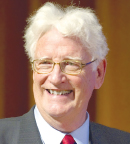
Peter Nowell, MD
Peter Nowell, MD, the Gaylord P. and Mary Louise Harnell Emeritus Professor of Pathology and Laboratory Medicine at the University of Pennsylvania, died on December 26, 2016, in Newtown Square, Pennsylvania. He was 88.
Dr. Nowell was a pathologist at the University of Pennsylvania studying leukemia cells under a microscope when he happened to wash his slides with tap water instead of laboratory solution. Viewing the newly cleaned slides under a microscope, he saw that the water had caused the cell’s chromosomes to expand as separate structures. “I didn’t know anything about chromosomes,” he told The Philadelphia Inquirer years later, “but it seemed a shame to throw this away.”
Dr. Nowell searched for an expert on chromosomes in the area to work with and found David A. Hunger, of Fox Chase Cancer Center (then the Institute for Cancer Research). The seminal observation was made that certain leukemia cells had an abnormally short chromosome 22. In 1959, that mutation was described as the Philadelphia chromosome. Dr. Nowell and his codiscoverer had opened a heretofore-closed window, showing the first clear sign of a genetic cause of cancer.
Dr. Nowell was born in Philadelphia on February 8, 1928. He went to Wesleyan University in Middletown, Connecticut, receiving a bachelor’s degree in biology and chemistry in 1948 and a medical degree from the University of Pennsylvania in 1952. That same year, Dr. Nowell married Helen Walker Worst, and they had five children.
Dr. Nowell spent 2 years in the Navy during the Korean War studying radiation and bone marrow transplantation, after which he joined the University of Pennsylvania faculty in 1956. From 1967 to 1973, Dr. Nowell served as chair of the university’s pathology department and as its cancer center’s first director, now known as the Abramson Cancer Center at the University of Pennsylvania. He spent the rest of his career at the University of Pennsylvania.
Dr. Nowell once reflected on the accidental nature of his discovery during an interview with the Lasker Foundation: “Serendipity plays a major role in biological progress. That’s why I tell people who are starting in the game to keep at least three or four different lines of investigation going, because the one that pays off is the one you don’t think will. As my old chief used to say, the real trick is to keep going out on different limbs and then decide how far out to go before you go back to the trunk of the tree, which is the main area you’re interested in.”
Dr. Nowell’s breakthrough scientific work produced monumental steps in the treatment of cancers. In 1998, Dr. Nowell, along with geneticists Drs. Janet D. Rowley and Alfred G. Knudson, Jr, received the Albert Lasker Clinical Medical Research Award. He was also elected to the National Academy of Sciences and the American Academy of Arts and Sciences. Upon the 50th anniversary of the Philadelphia chromosome discovery, the Franklin Institute awarded Dr. Nowell its Benjamin Franklin Medal in Life Science. In 2013, he was awarded the Albany Medical Center Prize in Medicine and Biomedical Research, and in 2014, he was elected Fellow of the American Association for Cancer Research. He also coauthored more than 400 publications.
His department colleagues posted a recollection of Dr. Nowell: “Peter cared deeply for his family and for his colleagues. As a cherished mentor, Peter embodied the model where ‘standing on the shoulders of giants’ has led to great discoveries and saved many lives.”
Albert H. Owens, Jr, MD
August 27, 1926–January 13, 2017
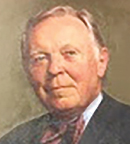
Albert H. Owens, Jr, MD
Albert H. Owens, Jr, MD, a Johns Hopkins oncologist who played a leadership role in developing oncology as a scientific discipline and clinical specialty—and who also served as President of The Johns Hopkins Hospital—died on January 13 at the age of 90.
In the 1960s, oncology was not a word that existed in the medical lexicon. Few specific medical facilities were set aside for cancer care, and there was no clearly recognized academic discipline. Dr. Owens, a 1949 graduate of the Johns Hopkins University School of Medicine and a member of its faculty since 1956, set about devoting his career to advancing cancer research and treatment.
“Al Owens, a founder of the field of medical oncology, built one of the nation’s great cancer centers. Al should receive a great deal of the credit for what cancer care and research have become today,” said William G. Nelson, MD, PhD, Director of the Johns Hopkins Kimmel Cancer Center.
In 1957, A. McGehee Harvey—then head of the Johns Hopkins University School of Medicine’s Department of Medicine—created a cancer research and treatment division within the department, noting that chemotherapy had recently joined radiotherapy and surgery as weapons in the battle against cancer. Mr. Harvey tapped Dr. Owens to head the new oncology division. Because at that time The Johns Hopkins Hospital lacked the space for such a service, Dr. Owens moved inpatient, clinical, and research oncology activities to Baltimore City Hospitals, now known as Johns Hopkins Bayview Medical Center. Dr. Owens opened Johns Hopkins’ first cancer chemotherapy unit at Baltimore City Hospitals in 1961, making it one of the first university-based centers of its kind.
In 1973, Dr. Owens—a slightly bashful, bow tie–wearing researcher and clinician—was named the first Director of the Johns Hopkins Oncology Center, which had won federal designation as one of the nation’s first comprehensive cancer centers. In 1977, Dr. Owens moved the center from Baltimore City Hospitals back to the main campus of The Johns Hopkins Hospital, where it was housed in a brand-new facility, named the Oncology Center. Over the next decade, the Johns Hopkins Oncology Center became one of the most prestigious cancer centers in the country and is now named the Sidney Kimmel Comprehensive Cancer Center at Johns Hopkins.
Dr. Owens was named President of The Johns Hopkins Hospital in 1987. Eighteen months later, he opted to relinquish the presidency to focus on developing the hospital’s new multimillion-dollar oncology center. Despite his brief tenure in the top job, the month he left, he decreed that the hospital would become smoke-free.
In addition to his positions at Johns Hopkins, Dr. Owens also served as President of the Maryland division of the American Cancer Society, President of the Association of American Cancer Institutes, and President of ASCO.
“Dr. Owens was not only a superb oncologist and mentor, but a first-rate gentleman,” said David Ettinger, MD, Alex Grass Professor of Oncology at the Johns Hopkins University School of Medicine.
Richmond T. Prehn, MD
December 8, 1922–November 7, 2016
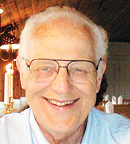
Richmond T. Prehn, MD
Until 1957, the prevailing thought was that since cancers develop in normal patients, they are not recognized as foreign by the immune system. That changed when Richmond T. Prehn, MD, and his laboratory assistant, Joan Main, showed that tumors induced by chemical carcinogens in mice could stimulate tumor-specific responses that were able to reject those same tumors on challenge. It was a paradigm shift in science, ultimately leading to the current boom in cancer immunology.
Dr. Prehn died at his home in Seattle on November 7, 2016. He was 93 years old.
Shortly after completing a general internship at the Philadelphia Naval Hospital, Dr. Prehn joined the laboratory of Howard B. Andervont, MD, at the National Cancer Institute (NCI) in Bethesda. Early during Dr. Prehn’s tenure, he accepted a commission in the U.S. Public Health Service and established his own independent laboratory at the NCI. During this period, he developed an interest in the possibility of immunity in relation to cancer in mice, although this line of inquiry was highly disputed at the time.
In 1955, Dr. Prehn received a request to discuss his work with NCI Director John R. Heller, Jr, MD. “After learning of my work, Dr. Heller, advised me, in no uncertain terms, to find some other interest with better prospects,” Dr. Prehn said in an interview.
Undaunted, he left the NCI in 1956 and began a residency in pathology at the Public Health Service hospital in Seattle. However, the experiments he had done at the NCI proved successful, culminating in his groundbreaking 1957 paper with Ms. Main, “Immunity to Methylcholanthrene-Induced Sarcomas.” On the basis of that paper, Dr. Prehn was offered an assistant professorship in pathology at the University of Washington in 1958. “That one paper was truly the foundation of my career,” noted Dr. Prehn.
Subsequently, he spent 10 years at the Institute for Cancer Research (which would eventually merge with the American Oncologic Hospital
to become Fox Chase Cancer Center) in Philadelphia; 5 years as Director of the Jackson Laboratory in Bar Harbor, Maine; and 5 years as Director of the California Institute for Medical Research in San Jose. He then returned to the University of Washington, where he spent the rest of his career.
Dr. Prehn was a tireless researcher who always challenged scientific orthodoxy. In addition to leaving his mark on the promising field of immunotherapy, Dr. Prehn was a teacher who inspired many future medical scientists. He is survived by his wife, four children, and five grandchildren.
Daniel J. Sargent, PhD
August 22, 1970–September 22, 2016
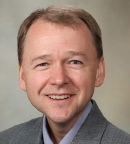
Daniel J. Sargent, PhD
Daniel J. Sargent, PhD. Dr. Sargent died unexpectedly following a brief acute illness on September 22, 2016. He was 46 years old. With his death, the oncology community lost a leader in statistical research and cancer clinical trial design.
Dr. Sargent was born on August 22, 1970, in Red Wing, Minnesota. At the age of 9, Dr. Sargent’s parents, Forrest and Faye Sargent, moved to Rochester, Minnesota, to start a family business: Sargent’s Landscape Nursery. While attending John Marshall High School, Dr. Sargent met Becky Warner, who became his high school sweetheart and later his wife. After graduating high school in 1988, they went on to attend college together at the University of Minnesota. They were married on August 21, 1993.
After receiving his undergraduate degree, Dr. Sargent received his PhD in biomedical statistics from the University of Minnesota, where he joined the Mayo Clinic in 1996. Dr. Sargent was a consultant in the Division of Biomedical Statistics and Informatics. He held the dual academic rank of Professor of Biostatistics and Oncology and served as the Section Head for the Section of Cancer Center Statistics since 2001.
Dr. Sargent’s research was in the area of oncology clinical trials, where he served as the Group Statistician for the Alliance for Clinical Trials in Oncology; Dr. Sargent also led multiple international groups including ACCENT in adjuvant colon cancer, the prospective IDEA in colon cancer, and the FLASH international consortia in follicular lymphoma.
In 2014, Dr. Sargent was awarded a $37.7 million, 5-year grant by the National Cancer Institute to lead the Alliance for Clinical Trials in Oncology Statistics and Data Center, which was located at the Mayo Clinic Cancer Center in Rochester.
When Dr. Sargent’s untimely death was announced, tributes poured in from colleagues and friends. Colleagues said he treasured his family and friends. He enjoyed traveling abroad and exploring new places with his wife and their children. He enjoyed the outdoors, downhill or cross-country skiing, hiking up north with his family, playing tennis, cheering on his children, Alec and Paige, during their tennis matches, or fishing and playing golf with his son.
While extolling his intellect and devotion to elevating the statistical science behind the development of cancer clinical trials, there was unanimous praise for Dr. Sargent’s gentility and common decency. David H. Ilson, MD, PhD, a gastrointestinal cancer expert from Memorial Sloan Kettering Cancer Center, said of Dr. Sargent: “Dan was internationally loved and respected as probably the finest trial statistician in GI oncology. His intelligence, humanity, warmth, collegiality, and wit promoted great international collaborations, which have had a positive impact on treatment and survival outcomes of patients with GI cancers. He was a giant in the field with humility and approachability. He is irreplaceable, and I cannot wrap myself around the enormity of the loss to all of us with his passing.”
Saul J. Sharkis, PhD
August 11, 1944–September 4, 2016
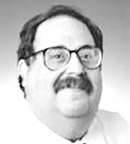
Saul J. Sharkis, PhD
Saul J. Sharkis, PhD, a scientist who studied the biology of blood stem cells and how they could be used to treat cancer through bone marrow transplantation, died on September 4, 2016. He was 72.
Dr. Sharkis was Professor of Oncology at the Johns Hopkins University School of Medicine and a faculty member in the Johns Hopkins Kimmel Cancer Center for more than 40 years. A native of New York, Dr. Sharkis earned his master’s and doctoral degrees from New York University. After completing his postdoctoral research at the National Naval Medical Center in Bethesda, he was recruited to the faculty of the Johns Hopkins University School of Medicine’s Department of Oncology.
Dr. Sharkis was among the first to isolate and study hematopoietic stem cells. His research was important to the progress of bone marrow and stem cell transplants, as it helped reveal the mechanisms of engraftment. His work also uncovered the biology of stem cells, isolating and tracking a stem cell population to show that small numbers of stem cells can reconstitute bone marrow following transplant.
“Saul inspired us with his dedication, invaluable knowledge, and experience. He was a brilliant yet humble man, a superb scientist, and a Johns Hopkins innovator,” said William G. Nelson, MD, PhD, Director of the Johns Hopkins Kimmel Cancer. “He will be sorely missed by countless residents, fellows, and colleagues.”
Oliver Smithies, PhD
June 25, 1925–January 10, 2017
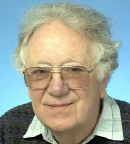
Oliver Smithies, PhD
The ability to artificially alter DNA opens the door to new scientific understanding and treatments for various diseases. Oliver Smithies, PhD, made the crucial discovery that a disease-causing gene could be modified. For that and other groundbreaking work, he, along with two other scientists, was awarded the 2007 Nobel Prize in Physiology or Medicine. Dr. Smithies died on January 10, 2017. He was 91 years old.
Dr. Smithies was born in the industrial town of Halifax, West Yorkshire, England, on June 25, 1925, to William and Doris Smithies. A bout with rheumatic fever at age 7 left him with a mitral valve murmur, which precluded him from playing sports for several years; during this time, he learned to enjoy reading and problem-solving. Sometime before he was 11, he read a comic book in which the star character was a mad scientist. Dr. Smithies recalled that from that moment, he also wanted to be a scientist, but not of the mad variety.
In 1946, Dr. Smithies was awarded his BA in animal physiology and chemistry from Balliol College at the University of Oxford. He received his PhD in biochemistry in 1951, after which he was awarded a postdoctoral fellowship in the United States at the laboratory of J.W. Williams at the University of Wisconsin-Madison’s Department of Chemistry. However, a visa problem forced him to leave the United States. He spent from 1953 to 1960 as an associate researcher in the Connaught Medical Research Laboratory at the University of Toronto, Canada. While there, he also learned genetics from Norma Ford Walker, PhD, at the Hospital for Sick Children.
Dr. Smithies returned to the University of Wisconsin-Madison in 1960, where he worked in the Department of Genetics until 1988, when he assumed the position of Professor of Pathology and Laboratory Medicine at the University of North Carolina at Chapel Hill. He continued his work there until well into his 80s. It was there where he developed gene targeting of mice, a method of replacing mouse genes using homologous recombination, which is the basis to investigate the role of particular genes in the development of several human diseases, such as cancer. For this pioneering work, he was awarded the Noble Prize in Physiology or Medicine in 2007.
Dr. Smithies, a naturalized American citizen, was a licensed pilot who enjoyed flying gliders. He was a self-proclaimed tinkerer and inventor who admitted he had trouble passing a junkyard without wandering in to look for useful items. In an interview, he summed up his inventor’s philosophy: “You use whatever is lying around, and you see something that needs to be done, and you try it. I think it is making things work, you know, somehow.”
Thomas E. Starzl, MD, PhD
March 11, 1926–March 4, 2017

Thomas E. Starzl, MD, PhD
Thomas E. Starzl, MD, PhD, who performed the world’s first successful liver transplant in 1967, died at his home in Pittsburgh on March 4, 2017, at the age of 90.
Dr. Starzl was born on March 11, 1926, in Le Mars, Iowa. His father owned the Le Mars Globe Post, and his mother juggled dual professions as a teacher and nurse. One of four siblings, Dr. Starzl originally set out to become a priest, but his career goals changed dramatically when his beloved mother died of breast cancer in 1947 at the age of 50. Dr. Starzl attributed his respect for the doctors who treated his mother throughout her illness as his inspiration to pursue a career in medicine.
As a boy, Dr. Starzl worked various jobs at his father’s newspaper (then called a “printer’s devil”), first as an apprentice who mixed tubs of ink and fetched type and then as a beat reporter. He would later attribute quickly sorting type at the newspaper as a task that helped build manual dexterity, which served him well in his surgical career. Despite growing up during the Great Depression, Dr. Starzl described his childhood as “normal.” He excelled in high school academics as a star athlete on the school’s football team and was a champion trumpet player.
After high school, Dr. Starzl served a year in the U.S. Navy, from 1944 to 1945, after which he obtained a BA from Westminster College in Missouri. He then attended Northwestern Medical School in Chicago, obtaining an MS in anatomy followed in 1952 by a PhD in neurophysiology and an MD with distinction.
Dr. Starzl then did an internship at The Johns Hopkins Hospital in Baltimore, a career-growing period from 1952 to 1959 of postgraduate surgical training. He acquired a wide range of surgical skills at the University of Miami and Northwestern University. During this period, his surgical and research trajectory began to form, especially during discussions with colleagues about the liver’s double blood supply.
For Dr. Starzl, the key was whether hormone and nutrient-rich portal blood was important for optimal metabolism and liver health. These scientific explorations led the way for his groundbreaking work in organ transplantation. Between March 1 and October 4, 1963, Dr. Starzl attempted five liver replacements; all five patients died of multiple causes.
After 3 years of nonsurgical self-reflection, Dr. Starzl and his colleagues tried again. They first considered inserting a second liver, to function beneath the impaired one, as a possible route to avoiding the heavy bleeding caused by organ removal. But promising results obtained from liver surgeries on dogs could not be replicated in humans, and that avenue was abandoned.
Dr. Starzl and his team transplanted a healthy liver in a 19-month-old with hepatic cancer. The transplanted liver functioned normally for more than a year, but the young girl died of other causes. Dr. Starzl would later describe the early transplants as “tests of endurance: brutality as you’re taking the liver out, then sophistication as you put it back and hook up all these little bile ducts and other structures.”
Although there was enough success in the early transplants to keep hope alive, Dr. Starzl and other transplant pioneers realized that long-term survival would depend on preventing the patient’s immune system from attacking the new liver. In the late 1970s, Dr. Starzl helped investigate cyclosporine to prevent liver rejection; after a series of trials at the Universities of Minnesota and Texas, cyclosporine won U.S. Food and Drug Administration (FDA) approval in 1983.
During this period, Dr. Starzl also began investigating an experimental antirejection drug called FK-506 (tacrolimus), using it on a multiple-organ transplant patient in 1984. Tacrolimus went on to become widely used in transplant surgeries.
Dr. Starzl lobbied intensely for the use of tacrolimus, studying it and publishing his findings in the The Lancet in 1989; the FDA approved it in 1994. The use of tacrolimus led to a medical breakthrough for patients and to Dr. Starzl’s appointment as Director of the University of Pittsburgh’s transplant unit in 1990. Some years later, the transplant unit was officially renamed the Thomas E. Starzl Transplantation Institute.
Dr. Starzl remained active in research as Distinguished Service Professor at the University of Pittsburgh. He received numerous awards during his remarkable career, including the Lasker Award for Clinical Science in 2005. His memoir, The Puzzle People: Memoirs of a Transplant Surgeon, was named by The Wall Street Journal as the third best book on the lives of physicians.
Roger Y. Tsien, PhD
February 1, 1952– August 24, 2016
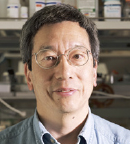
Roger Y. Tsien, PhD
In 2008, Roger Y. Tsien, PhD, shared the Nobel Prize in chemistry with Drs. Osamu Shimomura and Martin Chalfie for helping turn green fluorescent protein from a jellyfish into a research tool that could tag cancer cells or track the advance of Alzheimer’s disease. “Our work is often described as building and training molecular spies—molecules that will enter a cell or organism and report back to us what the conditions are, what’s going on with the biochemistry, while the cell is still alive,” Dr. Tsien said during an interview. Dr. Tsien died on August 24, 2016, in Eugene, Oregon. He was 64.
Dr. Tsien was a precocious child who suffered from asthma, spending a lot of time indoors conducting experiments in his makeshift basement laboratory. A notebook he kept as an 8-year-old is now a part of the Nobel Museum in Stockholm, Sweden. He used the notebook to write his chemistry experiments. When he was 16, Dr. Tsien won first prize in the Westinghouse Talent Search with a project investigating how metals bind to thiocyanate.
Courage, determination, creativity, and resourcefulness were hallmarks of his character. He accomplished much. He will not be forgotten..— Wendy Tsien
Tweet this quote
After high school, Dr. Tsien attended Harvard College on a National Merit Scholarship. He graduated summa cum laude with a degree in chemistry and physics in 1972. Dr. Tsien then earned a doctorate in physiology from the University of Cambridge, where he was a research fellow for a few years before joining the University of California (UC), Berkeley, and then UC San Diego, where his groundbreaking research truly accelerated.
Dr. Tsien was a member of the Institute of Medicine, the American Academy of Arts and Sciences, the U.S. National Academy of Sciences, and the Royal Society of London. He was the recipient of numerous awards, including the Gairdner Foundation International Award, the American Chemical Society Award for Creative Invention, the Heineken Prize for Biochemistry and Biophysics, the Max Delbruck Medal in Molecular Medicine, the Wolf Prize, and the Keio Medical Science Prize.
Dr. Tsien’s wife, Wendy, said of her late husband: “He was ever the adventurer, the pathfinder, the free and soaring spirit. Courage, determination, creativity, and resourcefulness were hallmarks of his character. He accomplished much. He will not be forgotten.”

